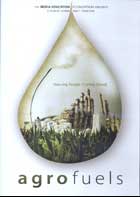
Agrofuels: Starving People, Fueling Greed 2012
Distributed by Media Education Foundation, 60 Masonic St., Northampton, MA 01060; 800-897-0089
Produced by Loren and Matt Feinstein
Directed by Loren and Matt Feinstein
DVD , color, 28 min.
Sr. High - General Adult
Science, Environmental Studies, Ethics, Biology, Agriculture
Date Entered: 05/23/2013
Reviewed by Andrew Koval, Mercyhurst University North East, North East, PAAgroFuels: Starving People, Fueling Greed seeks to correct the misconception that all alternative fuels are environmentally sustainable. The documentary provides a thoughtful explanation of the damage perpetuated from the production of agro-fuels in Brazil. Deforestation, human sickness from the use of herbicides/pesticides, and the monopolization of the agricultural market by corporations through the patenting of plants are all cited as challenges to environmental sustainability. Consequently, the documentary offers solutions on how to counteract agro-fuel production through creating awareness of the issue on a local level, consuming less, and saving heirloom seeds for food production. The film creates a sense of urgency for the viewer to take action.
The documentary presents facts that support the filmmakers claim that agro-fuel production is not environmentally sustainable. Moreover, the facts given are cited from recognized experts that are appropriate authorities on the subject. Likewise, definitions for key terms like monoculture and second generation fuels are well-defined for the viewer.
The weaknesses of the film are minimal. However, the documentary could have delved deeper into the sustainable countermeasures that are occurring among the indigenous populations of Brazil. Additionally, the filmmakers could have better distinguished the presentation of the biofuel crops versus agro-fuel crops by summoning more in-depth visual examples for both.
The technical merit of the film provides a critical yet streamlined assessment of the issues. The films pacing is expeditious. The way in which the camera captures the indigenous people gives the viewer a sense of being physically immersed in the location and circumstance of the people. The educational use of this documentary is best suited as an introductory overview of the problems associated with agro-fuel production. Further study will be required to more fully grasp the entire depth of the issues at hand. This film would be most appropriate for any government, college/university, law, nonprofit, or private library collection that is concerned with the environment, human health, and agriculture.